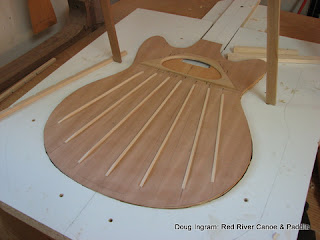Read more: http://bkocay.cs.umanitoba.ca/rivers/brigden/brigden.html
Bill became best known for his canoe building. Applying his racing experience he designed and built hundreds of fiberglass canoes. His most popular canoe is the recreational M3, of which he built over 600, and he would sell them for about $850.
Bill's approach to building would best be described as pragmatic. Simple, effective, and cheap are the operating principles.
This canoe is in for sanding and re-varnishing of the gunnels and other trim pieces. Also, the seat frames need new webbing. Bill used old lawn chair webbing. That is a plastic that breaks down significantly over time with exposure to UV light.

The wood grain decks are actually Formica.
 The seat frames are often old, broken, hockey sticks, good Ash wood available for cheap from local hockey rinks. I've repaired many of these seats and you can still see the labelling on the bottom of the seats.
The seat frames are often old, broken, hockey sticks, good Ash wood available for cheap from local hockey rinks. I've repaired many of these seats and you can still see the labelling on the bottom of the seats.Bill's canoes always had foot braces. He was way ahead of his time in this regard, unfortunately, most paddlers have no idea what they are for and the bar is often removed by the owners.

 The flotation in the chambers is just foam blocks stuck into a garbage bag to keep it all together. Necessary when the chamber is not water tight like most modern canoes.
The flotation in the chambers is just foam blocks stuck into a garbage bag to keep it all together. Necessary when the chamber is not water tight like most modern canoes.












































